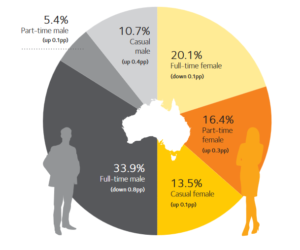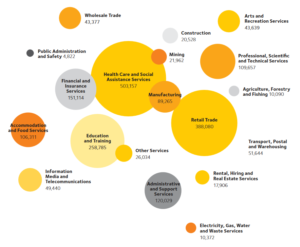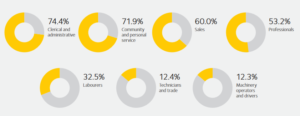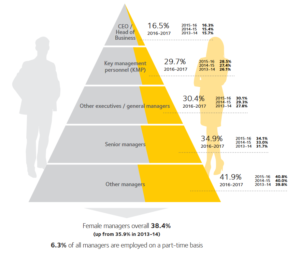Could do better? A mixed report card for gender equality

The latest ‘gender equality scorecard‘, released by the Federal Workplace Gender Equality Agency, shows the ever growing importance of women in Australia’s workforce, however major positions of company power are still largely held by men.
More employers are taking action to address the pay gaps and gender imbalances that persist across the economy, according to 2016-17 workplace data. The WGBA’s fourth annual report shows that more organisations are analysing pay gaps in their ranks and making managers accountable for gender equality outcomes, although progress is slow in terms of promoting women into managerial roles.
The overall pay gap between men and women in full time employment remains a hefty 22.4%, down just 0.7% since 2015-16. There is hope for future improvement however, as over a third of surveyed employers analysed differentials in their pay – 37.7%, up 10.8% on last year – and the number of firms including equal pay objectives in their published strategy has doubled, to 36.3% ,since 2013-14.
Men and Women in the Workplace
The WGEA data was collected between 1 April 2016 and March 31 this year. The survey covered over 11,000 companies of all sizes and 4 million Australian workers, 40% of the nation’s workforce.
Female jobs have grown across all employment categories, with the strongest growth in part-time work, and the number of women in the survey reached parity with men for the first time. 54.1% of workers surveyed were in full time employment, 21.8% were permanent part time employees and 24.1 were in casual jobs. However the number of full-time male jobs fell over the course of the year, with more men employed on a part time or casual basis instead. Mining and manufacturing saw the steepest falls in full time male jobs.
Women and men still tend to work in different industries. Just 7 out of 19 broad industrial sectors comprise at least 40% women and men. Female employment is most common in health care, social assistance and retail, for example, while men dominate construction and mining.
Women fulfill 51.3% of all non-managerial roles. Three quarters of clerical and administrative jobs are held by women, who also have 72% of the jobs in community and social service and 60% of posts in sales. Over half of all professionals – 53.2% – are now women.
Pay Gaps Persist
Despite this onward march of women in the workplace, the latest data confirms that every industry and occupation across the Australian workforce has a full-time gender pay gap favouring men. Women earn on average just 78% of men’s full-time earnings. The average annual pay packet of full-time female employees is $26,527 less than men’s, rising to $89,216 at the top level of management.
Pay gaps favouring men were also identified in every occupational category, from 8.4% for clerical and administrative workers (worth $6,472), 26.7% for technicians and trades workers (worth $28,042) and 31.9% in financial services.
Every managerial category and non-managerial occupation has a pay gap favouring men, driven by non-salary benefits such as bonuses at senior levels and reliance on awards. Collective agreements in some occupations and the concentration of women and men in different industries also maintain the gulf in pay. Although the gender pay gap declined slightly in all managerial categories over the past 12 months, it increased in some sectors, ranging from labouring to rental, hiring and real estate services. The difference between the gap in total remuneration (31.4%) and base salary (20.9%) in these services suggests that additional payments such as commissions are a differentiating factor.
The female-dominated industries of health care, social assistance, education and training also suffered an increase in the gender pay gap in the past 12 months. Perhaps significantly, these were also the industries least likely to conduct a pay gap analysis, with only 21% of health care and social assistance organisations and 17.8% of education and training bodies doing so. Organisations in financial and insurance services (64.3%) and mining (60.0%) were most likely to conduct a gender pay gap analysis, however the former maintained the highest gender gaps in pay.
About one in five organisations that analysed their own pay structure for gender disparities corrected like-for-like gaps (up 4.2% in the year to 21.0%) but fewer than one in 20 organisations set targets to reduce organisation-wide differentials (4.6%). Just over a quarter of organisations (28.0%) reported that they took no action to address pay gaps as they had gender pay equality.
Women in Management
The proportional of management roles performed by women has increased to 38.4%, compared to 35.9% in 2013-14. The number of employers with managerial key performance indicators related to gender equality has also increased, up 5% over the last year to 28.4%. However women are particularly under-represented in the upper leadership echelons, holding just 16.5% of CEO roles and 29.7% of key management personnel roles. Just a quarter of company board members are female, up a nominal 0.8% this year.
Mining and administrative and support services are the only sectors where women are not under-represented in management compared to their numbers in the rest of that industry. All other sectors, even female-dominated ones, have a lower proportion of women in management compared to women in the workforce. Agriculture, forestry and fishing (19.4%) and financial and insurance services (16.9%) – two very different types of jobs – have the biggest gap between numbers of women in the workforce and their representation in management.
In 2016-17, 43.4% of appointments and promotions to managerial roles involved women, up from 42.6% in 2015-16, suggesting the proportion of women in management will continue to grow. Only 6% of managers work part time however, reducing the scope for women with family roles.
Flexible Working
68.3% of the nation’s employers now have flexible work policies, an increase of 5.3% in a year. Financial and insurance services have the highest proportion of firms with a formal policy on flexible working arrangements (up 1.2% to 86.1%), while agriculture, forestry and fishing has the lowest proportion, down 2.1% to 48.9%. The strongest improvements were in education and training, up 11.4% to 58.4%, and construction up 9.4% to 53.5%.
However less than one in four organisations (24.2%) which offer a flexible working strategy train their managers in how to organise flexible work and fewer than one in 20 set targets for employee engagement in flexible working.
Women utilised 95.3% of all primary carer’s leave, but fewer than half of all employers offer paid parental leave in addition to the government scheme. The provision of paid parental leave varies significantly by industry and organisation size. In 2016-17, 45.9% of employers offered paid parental leave for primary carers, but this ranged from around 78% of employers in electricity, gas, water and waste services and education and training to just 20% in accommodation and food services and retail trade.
Larger corporates are more likely to offer additional family leave than mid-sized and smaller firms. 67.2% of organisations with more than 5000 employees offer extra time off work when required, for example, compared with just 39.7% of those with fewer than 250 employees. The average length of paid primary carer’s leave offered is 10.1 weeks. 39.3% of employers also offered paid parental leave for secondary carers, almost 95% of whom were men, with an average time off work of just 7.3 days.
Three quarters of all periods of paid parental leave were utilised by women. Though women are still more likely to quit their jobs entirely during parental leave, fewer people of both sexes left the workforce compared to last year. Women were seven times more likely than men to leave the workplace during parental leave, with 8.6% of women giving up their jobs, down 1.2% since 2015-16, compared to 1.2% of men, down 0.8%.
In-Work Support
The report found mixed progress on other forms of employee support. Although more firms claim to have formal policies to support employees with family and caring responsibilities, up 5.5% to 62.0%, the proportion of employers which actually offered non-leave based measures to support employees has declined for the second year in a row, down 4.4% over two years to 51.9%.
The most common non-leave based measures are breastfeeding facilities (32.9%) and referral services (24.7%). A derisory 3.4% of employers offer employer-subsidised childcare and only 3.7% offer return to work bonuses on a worker’s return from parental leave.
More employers have a formal policy to support employees who are suffering family or domestic violence, up 3.8% to 43.1% over the last year. The industry with the strongest increase in this regard was construction, up 10.4% since last year. Over eight in 10 (81.9%) employers offered other forms of support, including flexible working arrangements (61.0%), access to unpaid leave (59.6%) and referral to appropriate domestic violence support services for expert advice (34.9%).
WGEA Reaction
WGEA Director Libby Lyons was pleased with the improvement in employer awareness but called for a greater pace of change . Action, not words, is required when men still earn more than women in every industry and occupation. “This is not about women’s choices,” she wrote in the report “whether you are a manager, a scientist, a butcher, a baker or even a TV presenter, there is a gender pay gap favouring men.
“The sharp increases in employer action show that the momentum for improved gender equality is building. I am very encouraged that many more employers are now analysing their pay data for gender pay gaps and hopeful this will flow through to improved pay outcomes for women in the years ahead.
“Other positive developments include an increase in managers having KPIs related to gender equality and more women are being appointed to manager roles. Unfortunately, the number of women on boards remains static and too few organisations are reporting their gender metrics up to the board. We need to see some real change. Boards must take more accountability for gender equality.”












